UML Profiles: Analyzing Value and Impact on the Modelling Process
VerifiedAdded on 2023/05/31
|9
|1989
|437
Report
AI Summary
This report provides a comprehensive analysis of UML Profiles, a lightweight extension technique used in software and system design. It discusses the background of UML Profiles, their uses, and delves into different types such as SPT (Schedulability, Performance, and Time), QoS (Quality of Service), and UML-RT. The report compares these techniques, highlighting their strengths and weaknesses, and addresses the challenges associated with QoS profile requirement analysis, including QoS identification and prediction techniques. The conclusion emphasizes the importance of UML profiles in enhancing system design and development by providing opportunities to reveal imaginative aspects of the design, with each profile type offering specific benefits for performance, scheduling, quantitative analysis, and real-time environment design.
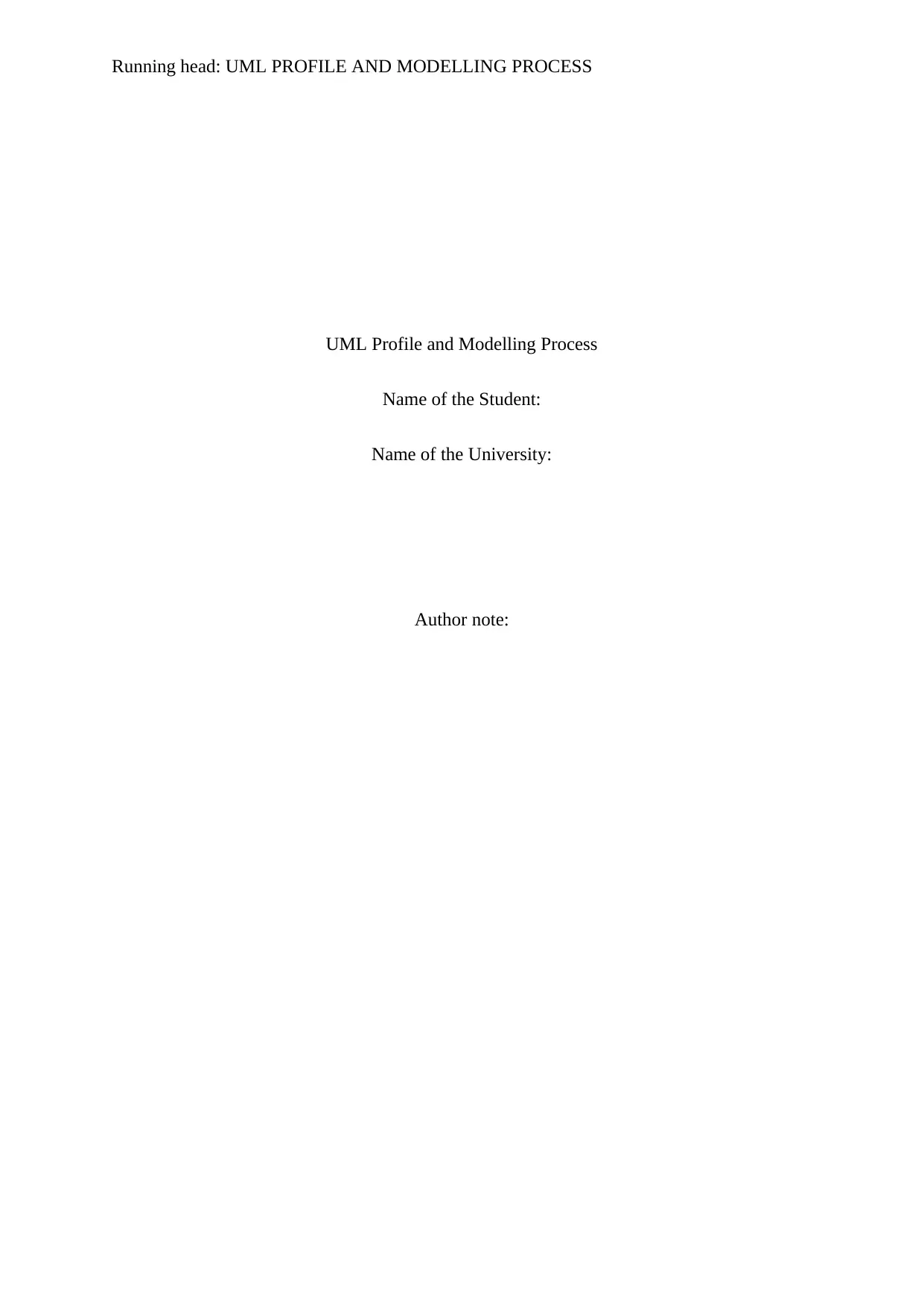
Running head: UML PROFILE AND MODELLING PROCESS
UML Profile and Modelling Process
Name of the Student:
Name of the University:
Author note:
UML Profile and Modelling Process
Name of the Student:
Name of the University:
Author note:
Paraphrase This Document
Need a fresh take? Get an instant paraphrase of this document with our AI Paraphraser
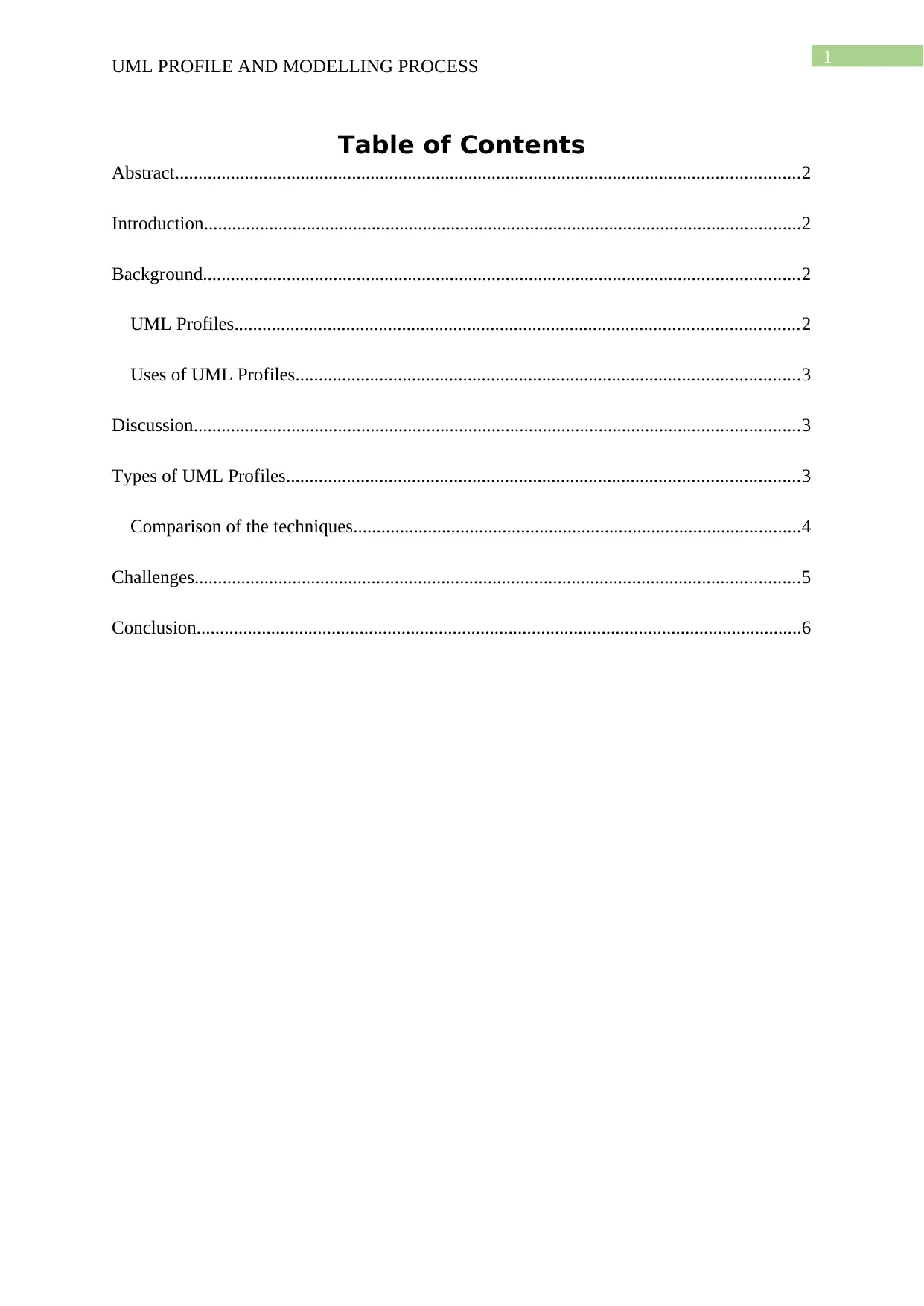
1
UML PROFILE AND MODELLING PROCESS
Table of Contents
Abstract......................................................................................................................................2
Introduction................................................................................................................................2
Background................................................................................................................................2
UML Profiles.........................................................................................................................2
Uses of UML Profiles............................................................................................................3
Discussion..................................................................................................................................3
Types of UML Profiles..............................................................................................................3
Comparison of the techniques................................................................................................4
Challenges..................................................................................................................................5
Conclusion..................................................................................................................................6
UML PROFILE AND MODELLING PROCESS
Table of Contents
Abstract......................................................................................................................................2
Introduction................................................................................................................................2
Background................................................................................................................................2
UML Profiles.........................................................................................................................2
Uses of UML Profiles............................................................................................................3
Discussion..................................................................................................................................3
Types of UML Profiles..............................................................................................................3
Comparison of the techniques................................................................................................4
Challenges..................................................................................................................................5
Conclusion..................................................................................................................................6
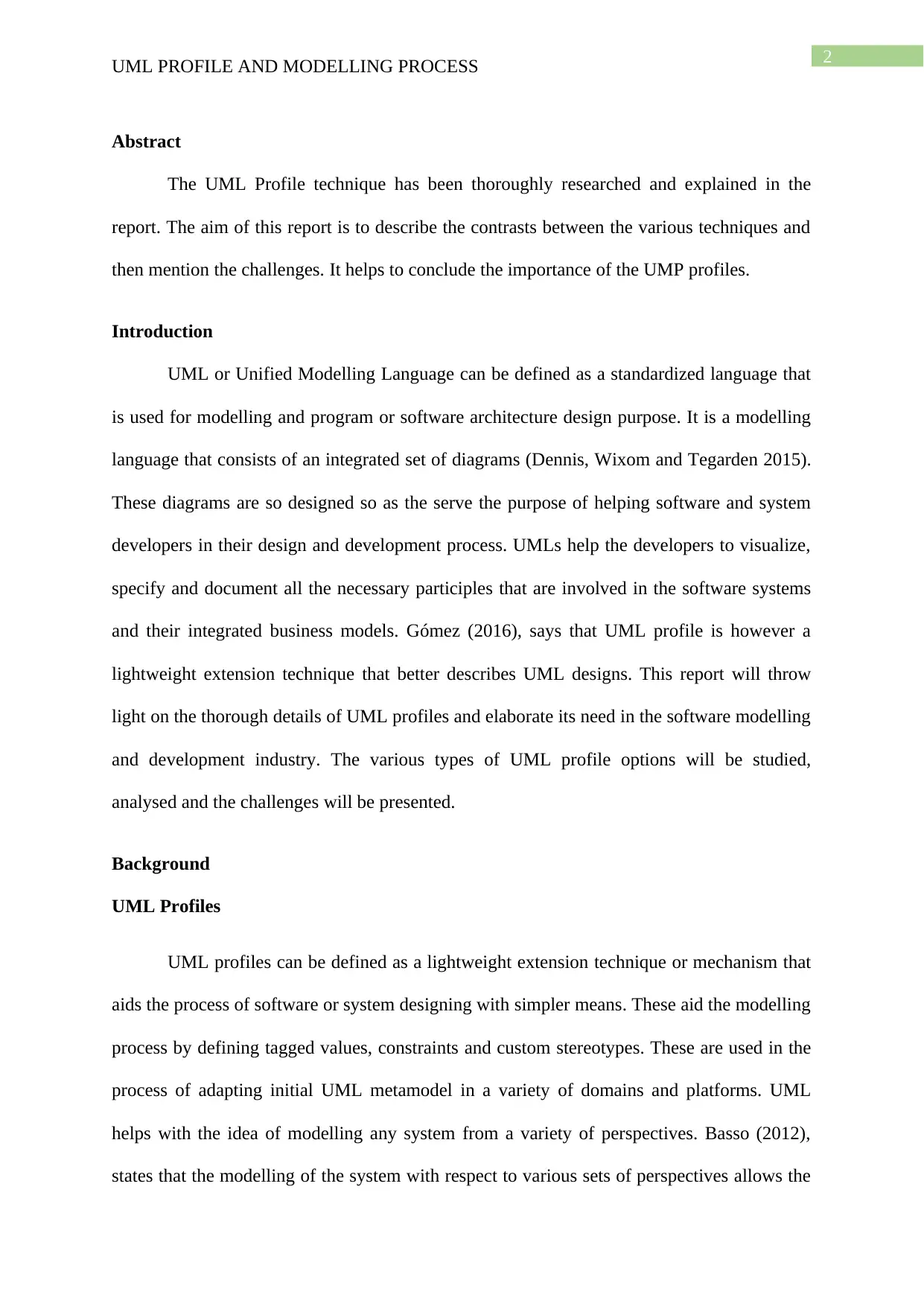
2
UML PROFILE AND MODELLING PROCESS
Abstract
The UML Profile technique has been thoroughly researched and explained in the
report. The aim of this report is to describe the contrasts between the various techniques and
then mention the challenges. It helps to conclude the importance of the UMP profiles.
Introduction
UML or Unified Modelling Language can be defined as a standardized language that
is used for modelling and program or software architecture design purpose. It is a modelling
language that consists of an integrated set of diagrams (Dennis, Wixom and Tegarden 2015).
These diagrams are so designed so as the serve the purpose of helping software and system
developers in their design and development process. UMLs help the developers to visualize,
specify and document all the necessary participles that are involved in the software systems
and their integrated business models. Gómez (2016), says that UML profile is however a
lightweight extension technique that better describes UML designs. This report will throw
light on the thorough details of UML profiles and elaborate its need in the software modelling
and development industry. The various types of UML profile options will be studied,
analysed and the challenges will be presented.
Background
UML Profiles
UML profiles can be defined as a lightweight extension technique or mechanism that
aids the process of software or system designing with simpler means. These aid the modelling
process by defining tagged values, constraints and custom stereotypes. These are used in the
process of adapting initial UML metamodel in a variety of domains and platforms. UML
helps with the idea of modelling any system from a variety of perspectives. Basso (2012),
states that the modelling of the system with respect to various sets of perspectives allows the
UML PROFILE AND MODELLING PROCESS
Abstract
The UML Profile technique has been thoroughly researched and explained in the
report. The aim of this report is to describe the contrasts between the various techniques and
then mention the challenges. It helps to conclude the importance of the UMP profiles.
Introduction
UML or Unified Modelling Language can be defined as a standardized language that
is used for modelling and program or software architecture design purpose. It is a modelling
language that consists of an integrated set of diagrams (Dennis, Wixom and Tegarden 2015).
These diagrams are so designed so as the serve the purpose of helping software and system
developers in their design and development process. UMLs help the developers to visualize,
specify and document all the necessary participles that are involved in the software systems
and their integrated business models. Gómez (2016), says that UML profile is however a
lightweight extension technique that better describes UML designs. This report will throw
light on the thorough details of UML profiles and elaborate its need in the software modelling
and development industry. The various types of UML profile options will be studied,
analysed and the challenges will be presented.
Background
UML Profiles
UML profiles can be defined as a lightweight extension technique or mechanism that
aids the process of software or system designing with simpler means. These aid the modelling
process by defining tagged values, constraints and custom stereotypes. These are used in the
process of adapting initial UML metamodel in a variety of domains and platforms. UML
helps with the idea of modelling any system from a variety of perspectives. Basso (2012),
states that the modelling of the system with respect to various sets of perspectives allows the
⊘ This is a preview!⊘
Do you want full access?
Subscribe today to unlock all pages.

Trusted by 1+ million students worldwide
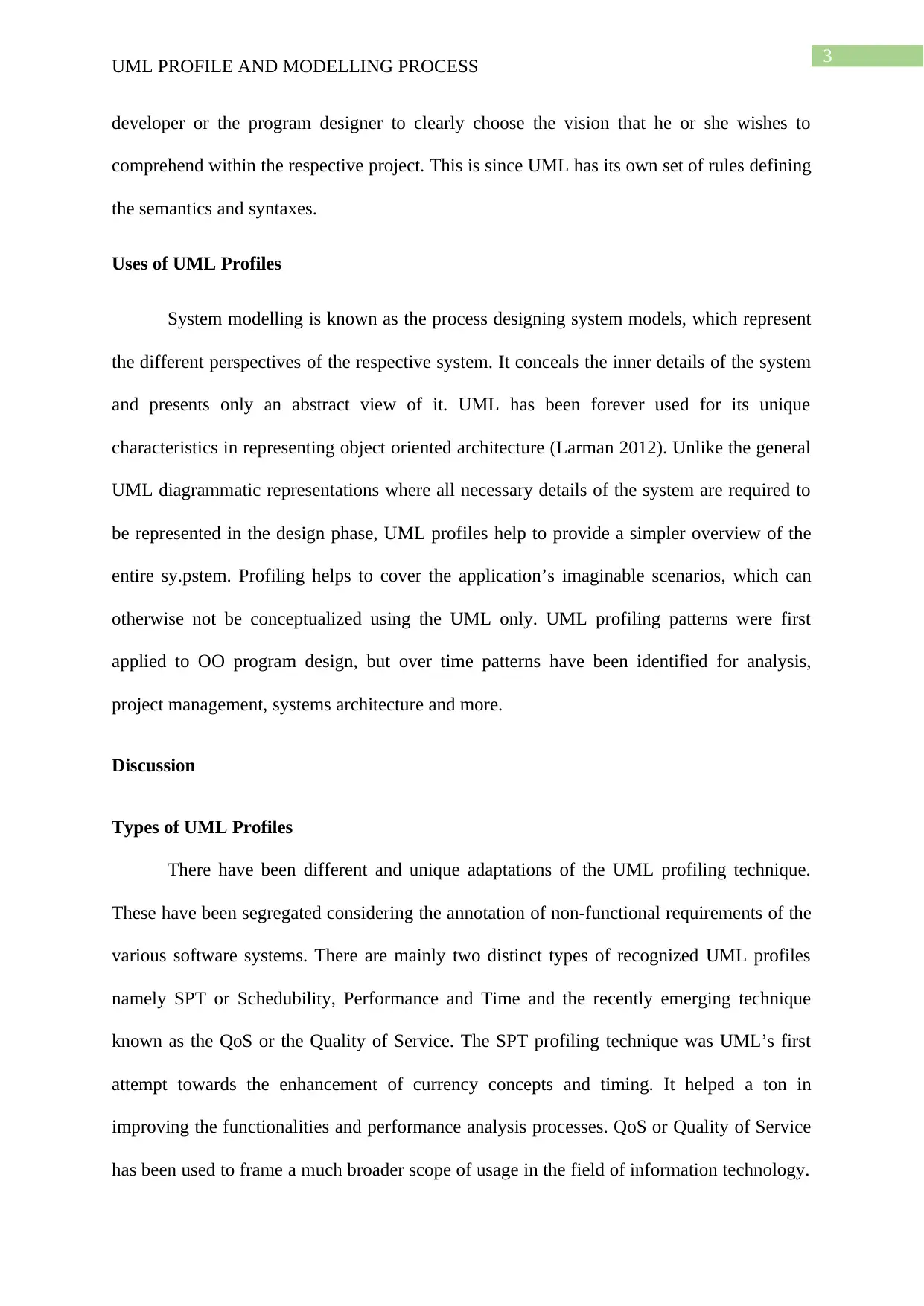
3
UML PROFILE AND MODELLING PROCESS
developer or the program designer to clearly choose the vision that he or she wishes to
comprehend within the respective project. This is since UML has its own set of rules defining
the semantics and syntaxes.
Uses of UML Profiles
System modelling is known as the process designing system models, which represent
the different perspectives of the respective system. It conceals the inner details of the system
and presents only an abstract view of it. UML has been forever used for its unique
characteristics in representing object oriented architecture (Larman 2012). Unlike the general
UML diagrammatic representations where all necessary details of the system are required to
be represented in the design phase, UML profiles help to provide a simpler overview of the
entire sy.pstem. Profiling helps to cover the application’s imaginable scenarios, which can
otherwise not be conceptualized using the UML only. UML profiling patterns were first
applied to OO program design, but over time patterns have been identified for analysis,
project management, systems architecture and more.
Discussion
Types of UML Profiles
There have been different and unique adaptations of the UML profiling technique.
These have been segregated considering the annotation of non-functional requirements of the
various software systems. There are mainly two distinct types of recognized UML profiles
namely SPT or Schedubility, Performance and Time and the recently emerging technique
known as the QoS or the Quality of Service. The SPT profiling technique was UML’s first
attempt towards the enhancement of currency concepts and timing. It helped a ton in
improving the functionalities and performance analysis processes. QoS or Quality of Service
has been used to frame a much broader scope of usage in the field of information technology.
UML PROFILE AND MODELLING PROCESS
developer or the program designer to clearly choose the vision that he or she wishes to
comprehend within the respective project. This is since UML has its own set of rules defining
the semantics and syntaxes.
Uses of UML Profiles
System modelling is known as the process designing system models, which represent
the different perspectives of the respective system. It conceals the inner details of the system
and presents only an abstract view of it. UML has been forever used for its unique
characteristics in representing object oriented architecture (Larman 2012). Unlike the general
UML diagrammatic representations where all necessary details of the system are required to
be represented in the design phase, UML profiles help to provide a simpler overview of the
entire sy.pstem. Profiling helps to cover the application’s imaginable scenarios, which can
otherwise not be conceptualized using the UML only. UML profiling patterns were first
applied to OO program design, but over time patterns have been identified for analysis,
project management, systems architecture and more.
Discussion
Types of UML Profiles
There have been different and unique adaptations of the UML profiling technique.
These have been segregated considering the annotation of non-functional requirements of the
various software systems. There are mainly two distinct types of recognized UML profiles
namely SPT or Schedubility, Performance and Time and the recently emerging technique
known as the QoS or the Quality of Service. The SPT profiling technique was UML’s first
attempt towards the enhancement of currency concepts and timing. It helped a ton in
improving the functionalities and performance analysis processes. QoS or Quality of Service
has been used to frame a much broader scope of usage in the field of information technology.
Paraphrase This Document
Need a fresh take? Get an instant paraphrase of this document with our AI Paraphraser
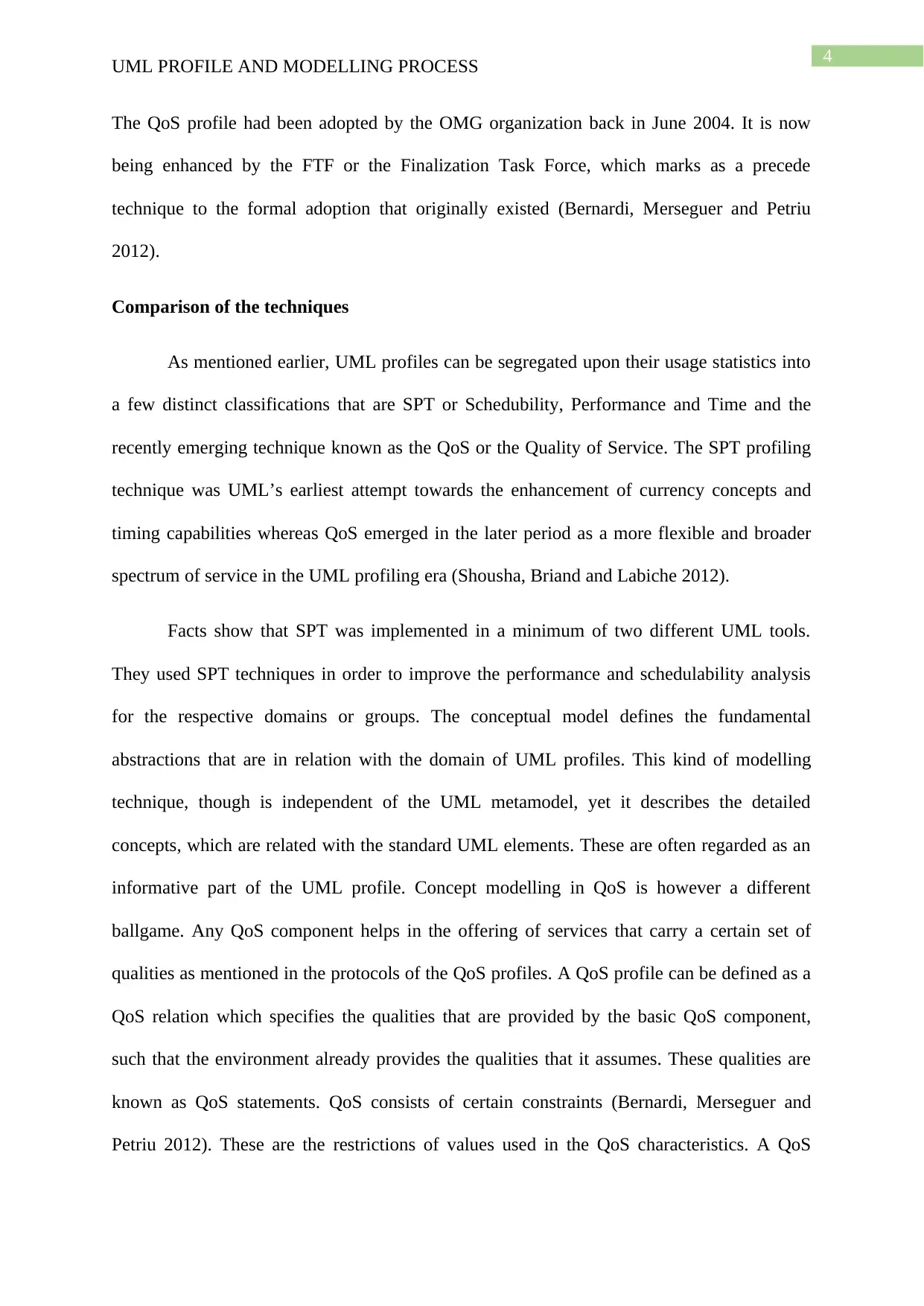
4
UML PROFILE AND MODELLING PROCESS
The QoS profile had been adopted by the OMG organization back in June 2004. It is now
being enhanced by the FTF or the Finalization Task Force, which marks as a precede
technique to the formal adoption that originally existed (Bernardi, Merseguer and Petriu
2012).
Comparison of the techniques
As mentioned earlier, UML profiles can be segregated upon their usage statistics into
a few distinct classifications that are SPT or Schedubility, Performance and Time and the
recently emerging technique known as the QoS or the Quality of Service. The SPT profiling
technique was UML’s earliest attempt towards the enhancement of currency concepts and
timing capabilities whereas QoS emerged in the later period as a more flexible and broader
spectrum of service in the UML profiling era (Shousha, Briand and Labiche 2012).
Facts show that SPT was implemented in a minimum of two different UML tools.
They used SPT techniques in order to improve the performance and schedulability analysis
for the respective domains or groups. The conceptual model defines the fundamental
abstractions that are in relation with the domain of UML profiles. This kind of modelling
technique, though is independent of the UML metamodel, yet it describes the detailed
concepts, which are related with the standard UML elements. These are often regarded as an
informative part of the UML profile. Concept modelling in QoS is however a different
ballgame. Any QoS component helps in the offering of services that carry a certain set of
qualities as mentioned in the protocols of the QoS profiles. A QoS profile can be defined as a
QoS relation which specifies the qualities that are provided by the basic QoS component,
such that the environment already provides the qualities that it assumes. These qualities are
known as QoS statements. QoS consists of certain constraints (Bernardi, Merseguer and
Petriu 2012). These are the restrictions of values used in the QoS characteristics. A QoS
UML PROFILE AND MODELLING PROCESS
The QoS profile had been adopted by the OMG organization back in June 2004. It is now
being enhanced by the FTF or the Finalization Task Force, which marks as a precede
technique to the formal adoption that originally existed (Bernardi, Merseguer and Petriu
2012).
Comparison of the techniques
As mentioned earlier, UML profiles can be segregated upon their usage statistics into
a few distinct classifications that are SPT or Schedubility, Performance and Time and the
recently emerging technique known as the QoS or the Quality of Service. The SPT profiling
technique was UML’s earliest attempt towards the enhancement of currency concepts and
timing capabilities whereas QoS emerged in the later period as a more flexible and broader
spectrum of service in the UML profiling era (Shousha, Briand and Labiche 2012).
Facts show that SPT was implemented in a minimum of two different UML tools.
They used SPT techniques in order to improve the performance and schedulability analysis
for the respective domains or groups. The conceptual model defines the fundamental
abstractions that are in relation with the domain of UML profiles. This kind of modelling
technique, though is independent of the UML metamodel, yet it describes the detailed
concepts, which are related with the standard UML elements. These are often regarded as an
informative part of the UML profile. Concept modelling in QoS is however a different
ballgame. Any QoS component helps in the offering of services that carry a certain set of
qualities as mentioned in the protocols of the QoS profiles. A QoS profile can be defined as a
QoS relation which specifies the qualities that are provided by the basic QoS component,
such that the environment already provides the qualities that it assumes. These qualities are
known as QoS statements. QoS consists of certain constraints (Bernardi, Merseguer and
Petriu 2012). These are the restrictions of values used in the QoS characteristics. A QoS
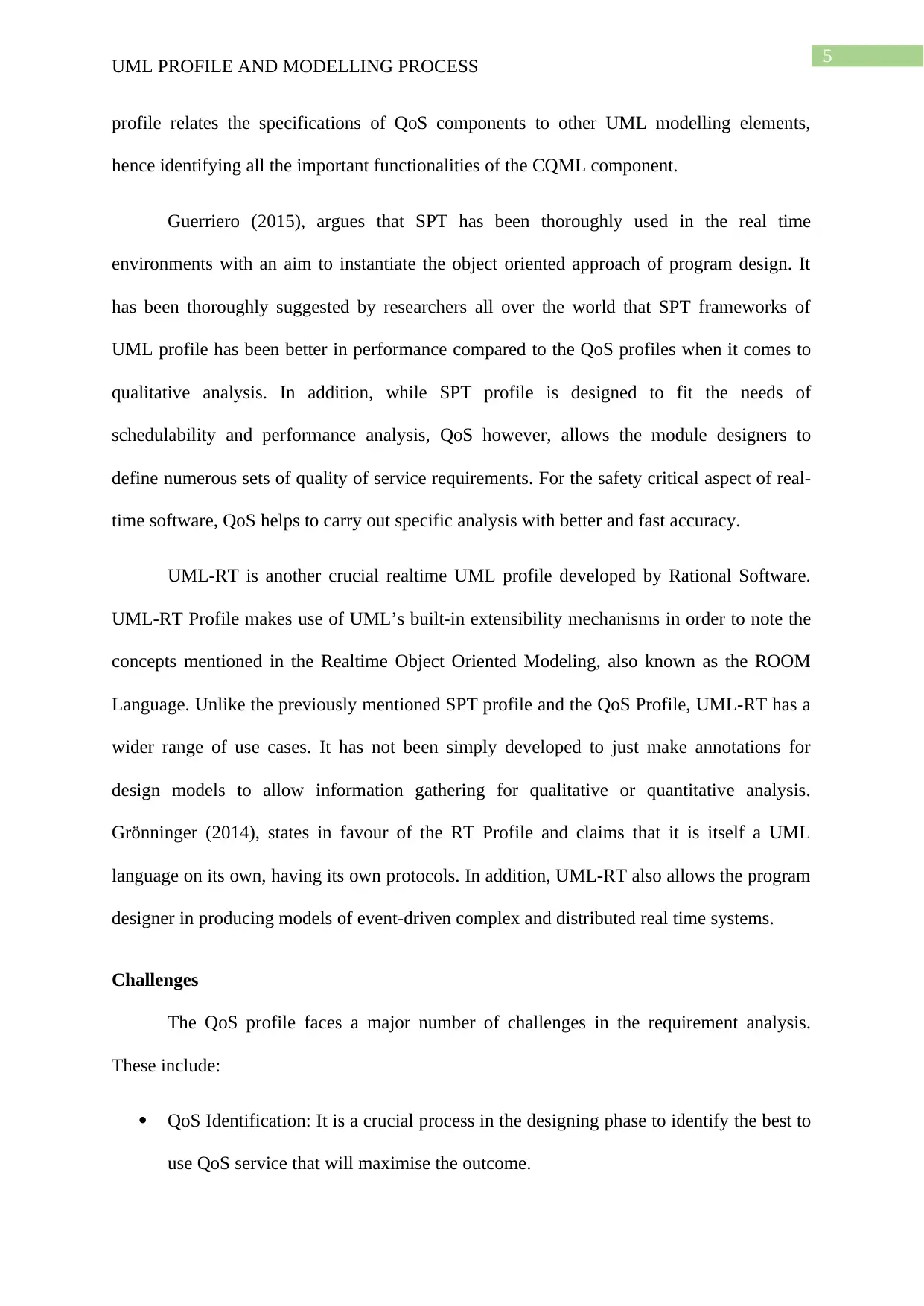
5
UML PROFILE AND MODELLING PROCESS
profile relates the specifications of QoS components to other UML modelling elements,
hence identifying all the important functionalities of the CQML component.
Guerriero (2015), argues that SPT has been thoroughly used in the real time
environments with an aim to instantiate the object oriented approach of program design. It
has been thoroughly suggested by researchers all over the world that SPT frameworks of
UML profile has been better in performance compared to the QoS profiles when it comes to
qualitative analysis. In addition, while SPT profile is designed to fit the needs of
schedulability and performance analysis, QoS however, allows the module designers to
define numerous sets of quality of service requirements. For the safety critical aspect of real-
time software, QoS helps to carry out specific analysis with better and fast accuracy.
UML-RT is another crucial realtime UML profile developed by Rational Software.
UML-RT Profile makes use of UML’s built-in extensibility mechanisms in order to note the
concepts mentioned in the Realtime Object Oriented Modeling, also known as the ROOM
Language. Unlike the previously mentioned SPT profile and the QoS Profile, UML-RT has a
wider range of use cases. It has not been simply developed to just make annotations for
design models to allow information gathering for qualitative or quantitative analysis.
Grönninger (2014), states in favour of the RT Profile and claims that it is itself a UML
language on its own, having its own protocols. In addition, UML-RT also allows the program
designer in producing models of event-driven complex and distributed real time systems.
Challenges
The QoS profile faces a major number of challenges in the requirement analysis.
These include:
QoS Identification: It is a crucial process in the designing phase to identify the best to
use QoS service that will maximise the outcome.
UML PROFILE AND MODELLING PROCESS
profile relates the specifications of QoS components to other UML modelling elements,
hence identifying all the important functionalities of the CQML component.
Guerriero (2015), argues that SPT has been thoroughly used in the real time
environments with an aim to instantiate the object oriented approach of program design. It
has been thoroughly suggested by researchers all over the world that SPT frameworks of
UML profile has been better in performance compared to the QoS profiles when it comes to
qualitative analysis. In addition, while SPT profile is designed to fit the needs of
schedulability and performance analysis, QoS however, allows the module designers to
define numerous sets of quality of service requirements. For the safety critical aspect of real-
time software, QoS helps to carry out specific analysis with better and fast accuracy.
UML-RT is another crucial realtime UML profile developed by Rational Software.
UML-RT Profile makes use of UML’s built-in extensibility mechanisms in order to note the
concepts mentioned in the Realtime Object Oriented Modeling, also known as the ROOM
Language. Unlike the previously mentioned SPT profile and the QoS Profile, UML-RT has a
wider range of use cases. It has not been simply developed to just make annotations for
design models to allow information gathering for qualitative or quantitative analysis.
Grönninger (2014), states in favour of the RT Profile and claims that it is itself a UML
language on its own, having its own protocols. In addition, UML-RT also allows the program
designer in producing models of event-driven complex and distributed real time systems.
Challenges
The QoS profile faces a major number of challenges in the requirement analysis.
These include:
QoS Identification: It is a crucial process in the designing phase to identify the best to
use QoS service that will maximise the outcome.
⊘ This is a preview!⊘
Do you want full access?
Subscribe today to unlock all pages.

Trusted by 1+ million students worldwide
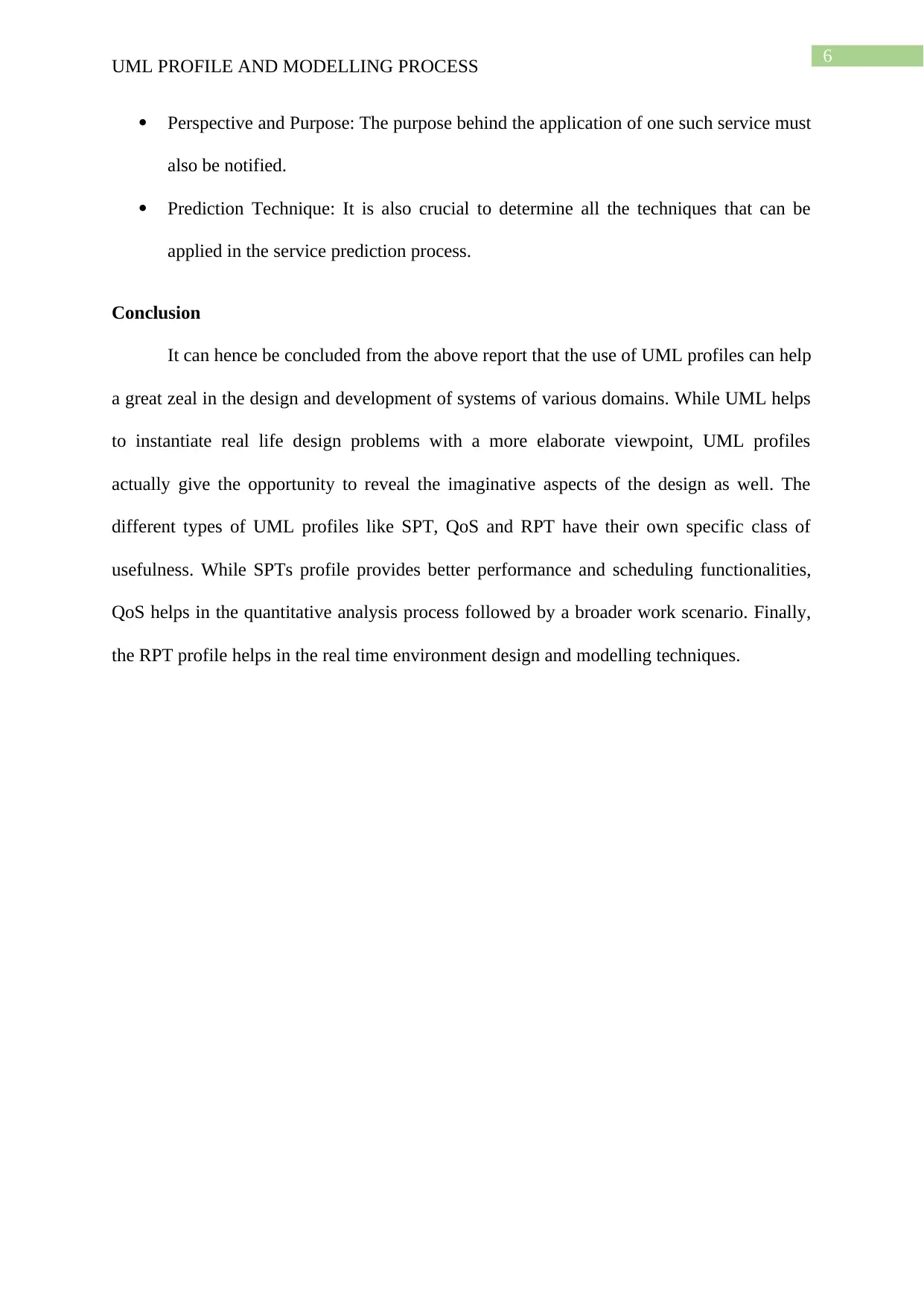
6
UML PROFILE AND MODELLING PROCESS
Perspective and Purpose: The purpose behind the application of one such service must
also be notified.
Prediction Technique: It is also crucial to determine all the techniques that can be
applied in the service prediction process.
Conclusion
It can hence be concluded from the above report that the use of UML profiles can help
a great zeal in the design and development of systems of various domains. While UML helps
to instantiate real life design problems with a more elaborate viewpoint, UML profiles
actually give the opportunity to reveal the imaginative aspects of the design as well. The
different types of UML profiles like SPT, QoS and RPT have their own specific class of
usefulness. While SPTs profile provides better performance and scheduling functionalities,
QoS helps in the quantitative analysis process followed by a broader work scenario. Finally,
the RPT profile helps in the real time environment design and modelling techniques.
UML PROFILE AND MODELLING PROCESS
Perspective and Purpose: The purpose behind the application of one such service must
also be notified.
Prediction Technique: It is also crucial to determine all the techniques that can be
applied in the service prediction process.
Conclusion
It can hence be concluded from the above report that the use of UML profiles can help
a great zeal in the design and development of systems of various domains. While UML helps
to instantiate real life design problems with a more elaborate viewpoint, UML profiles
actually give the opportunity to reveal the imaginative aspects of the design as well. The
different types of UML profiles like SPT, QoS and RPT have their own specific class of
usefulness. While SPTs profile provides better performance and scheduling functionalities,
QoS helps in the quantitative analysis process followed by a broader work scenario. Finally,
the RPT profile helps in the real time environment design and modelling techniques.
Paraphrase This Document
Need a fresh take? Get an instant paraphrase of this document with our AI Paraphraser
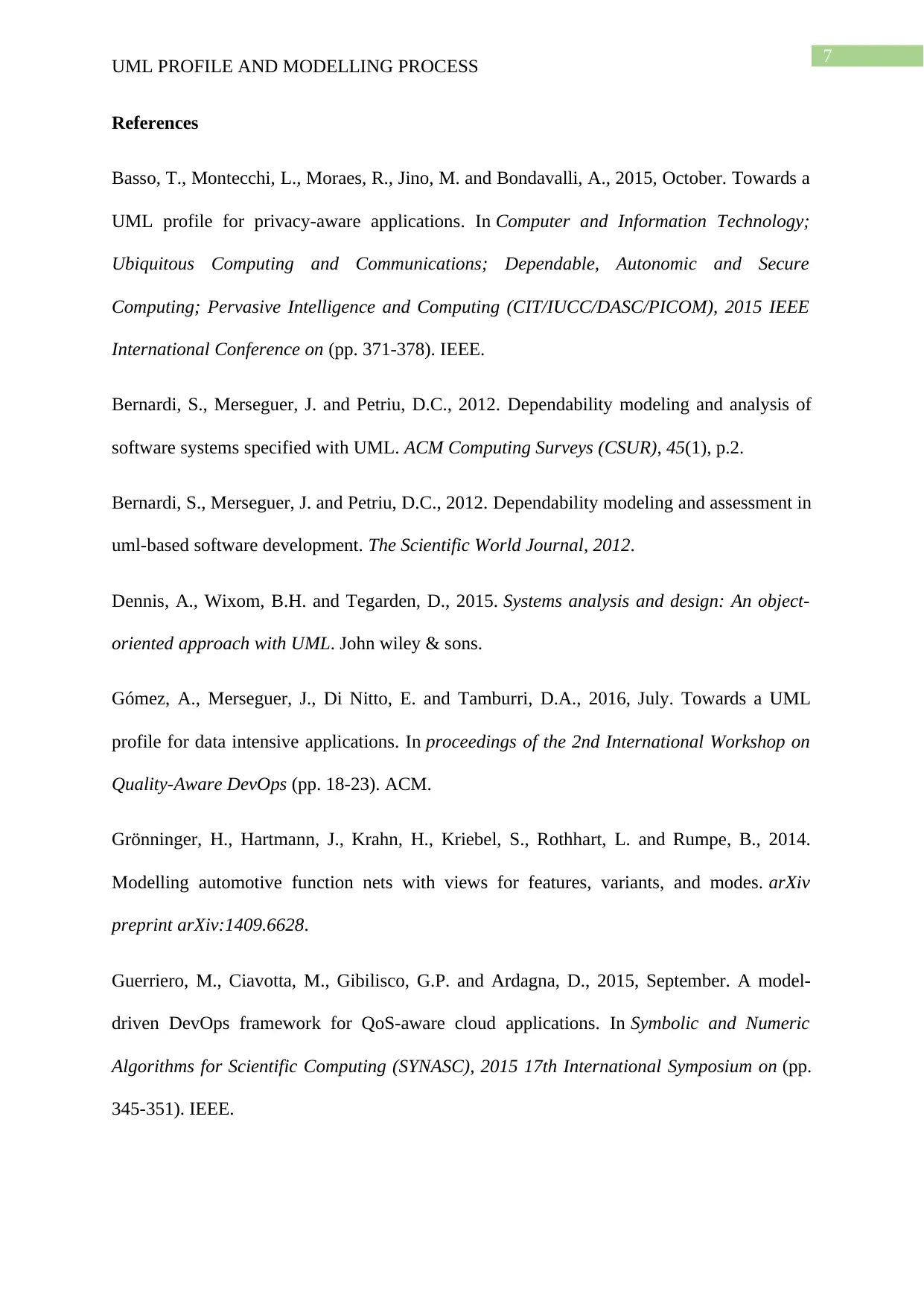
7
UML PROFILE AND MODELLING PROCESS
References
Basso, T., Montecchi, L., Moraes, R., Jino, M. and Bondavalli, A., 2015, October. Towards a
UML profile for privacy-aware applications. In Computer and Information Technology;
Ubiquitous Computing and Communications; Dependable, Autonomic and Secure
Computing; Pervasive Intelligence and Computing (CIT/IUCC/DASC/PICOM), 2015 IEEE
International Conference on (pp. 371-378). IEEE.
Bernardi, S., Merseguer, J. and Petriu, D.C., 2012. Dependability modeling and analysis of
software systems specified with UML. ACM Computing Surveys (CSUR), 45(1), p.2.
Bernardi, S., Merseguer, J. and Petriu, D.C., 2012. Dependability modeling and assessment in
uml-based software development. The Scientific World Journal, 2012.
Dennis, A., Wixom, B.H. and Tegarden, D., 2015. Systems analysis and design: An object-
oriented approach with UML. John wiley & sons.
Gómez, A., Merseguer, J., Di Nitto, E. and Tamburri, D.A., 2016, July. Towards a UML
profile for data intensive applications. In proceedings of the 2nd International Workshop on
Quality-Aware DevOps (pp. 18-23). ACM.
Grönninger, H., Hartmann, J., Krahn, H., Kriebel, S., Rothhart, L. and Rumpe, B., 2014.
Modelling automotive function nets with views for features, variants, and modes. arXiv
preprint arXiv:1409.6628.
Guerriero, M., Ciavotta, M., Gibilisco, G.P. and Ardagna, D., 2015, September. A model-
driven DevOps framework for QoS-aware cloud applications. In Symbolic and Numeric
Algorithms for Scientific Computing (SYNASC), 2015 17th International Symposium on (pp.
345-351). IEEE.
UML PROFILE AND MODELLING PROCESS
References
Basso, T., Montecchi, L., Moraes, R., Jino, M. and Bondavalli, A., 2015, October. Towards a
UML profile for privacy-aware applications. In Computer and Information Technology;
Ubiquitous Computing and Communications; Dependable, Autonomic and Secure
Computing; Pervasive Intelligence and Computing (CIT/IUCC/DASC/PICOM), 2015 IEEE
International Conference on (pp. 371-378). IEEE.
Bernardi, S., Merseguer, J. and Petriu, D.C., 2012. Dependability modeling and analysis of
software systems specified with UML. ACM Computing Surveys (CSUR), 45(1), p.2.
Bernardi, S., Merseguer, J. and Petriu, D.C., 2012. Dependability modeling and assessment in
uml-based software development. The Scientific World Journal, 2012.
Dennis, A., Wixom, B.H. and Tegarden, D., 2015. Systems analysis and design: An object-
oriented approach with UML. John wiley & sons.
Gómez, A., Merseguer, J., Di Nitto, E. and Tamburri, D.A., 2016, July. Towards a UML
profile for data intensive applications. In proceedings of the 2nd International Workshop on
Quality-Aware DevOps (pp. 18-23). ACM.
Grönninger, H., Hartmann, J., Krahn, H., Kriebel, S., Rothhart, L. and Rumpe, B., 2014.
Modelling automotive function nets with views for features, variants, and modes. arXiv
preprint arXiv:1409.6628.
Guerriero, M., Ciavotta, M., Gibilisco, G.P. and Ardagna, D., 2015, September. A model-
driven DevOps framework for QoS-aware cloud applications. In Symbolic and Numeric
Algorithms for Scientific Computing (SYNASC), 2015 17th International Symposium on (pp.
345-351). IEEE.
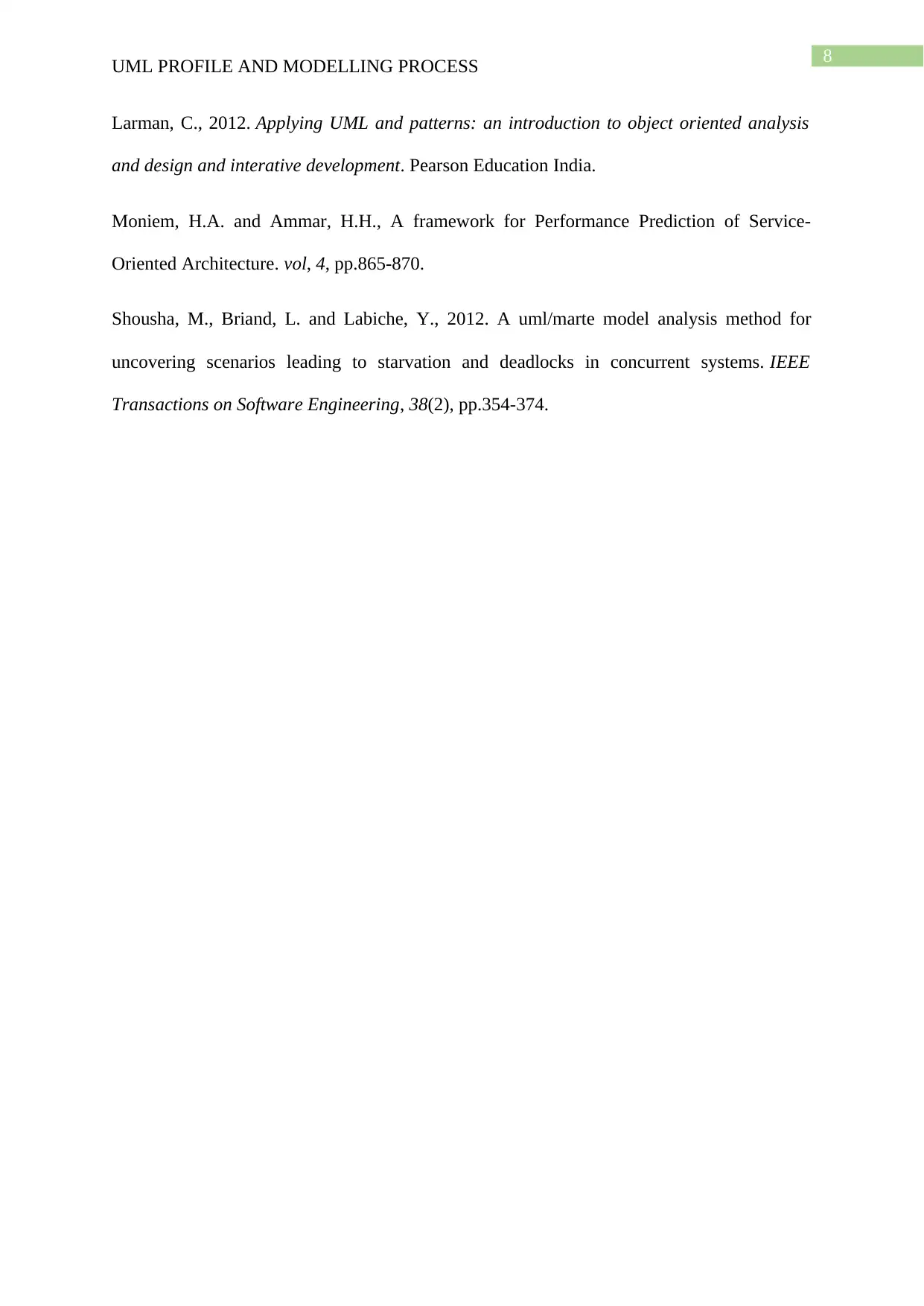
8
UML PROFILE AND MODELLING PROCESS
Larman, C., 2012. Applying UML and patterns: an introduction to object oriented analysis
and design and interative development. Pearson Education India.
Moniem, H.A. and Ammar, H.H., A framework for Performance Prediction of Service-
Oriented Architecture. vol, 4, pp.865-870.
Shousha, M., Briand, L. and Labiche, Y., 2012. A uml/marte model analysis method for
uncovering scenarios leading to starvation and deadlocks in concurrent systems. IEEE
Transactions on Software Engineering, 38(2), pp.354-374.
UML PROFILE AND MODELLING PROCESS
Larman, C., 2012. Applying UML and patterns: an introduction to object oriented analysis
and design and interative development. Pearson Education India.
Moniem, H.A. and Ammar, H.H., A framework for Performance Prediction of Service-
Oriented Architecture. vol, 4, pp.865-870.
Shousha, M., Briand, L. and Labiche, Y., 2012. A uml/marte model analysis method for
uncovering scenarios leading to starvation and deadlocks in concurrent systems. IEEE
Transactions on Software Engineering, 38(2), pp.354-374.
⊘ This is a preview!⊘
Do you want full access?
Subscribe today to unlock all pages.

Trusted by 1+ million students worldwide
1 out of 9
Related Documents
Your All-in-One AI-Powered Toolkit for Academic Success.
+13062052269
info@desklib.com
Available 24*7 on WhatsApp / Email
![[object Object]](/_next/static/media/star-bottom.7253800d.svg)
Unlock your academic potential
Copyright © 2020–2025 A2Z Services. All Rights Reserved. Developed and managed by ZUCOL.




